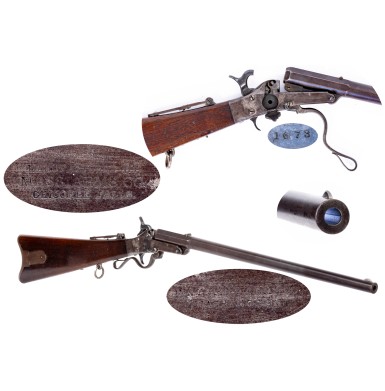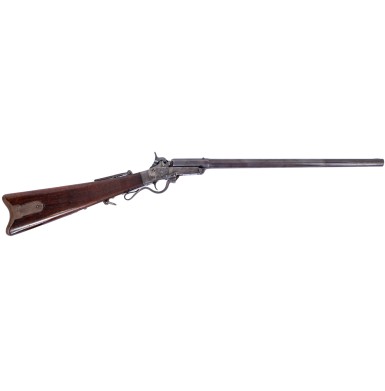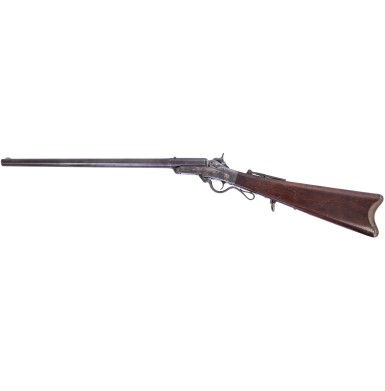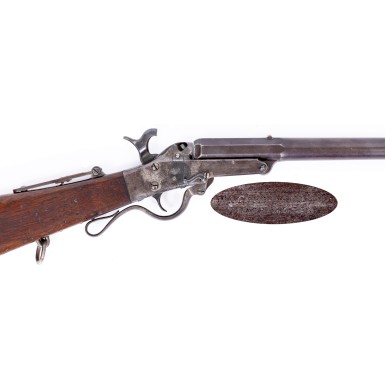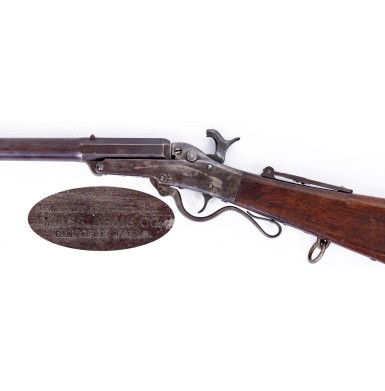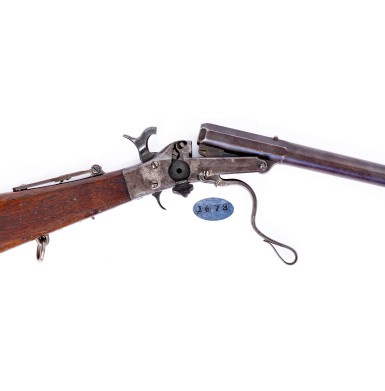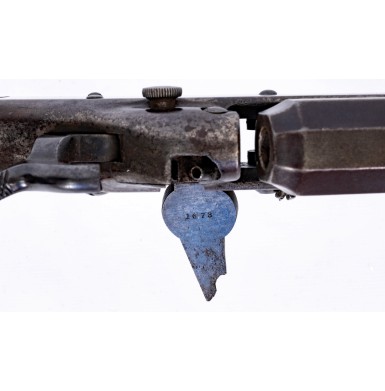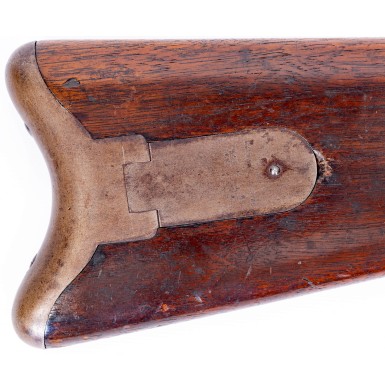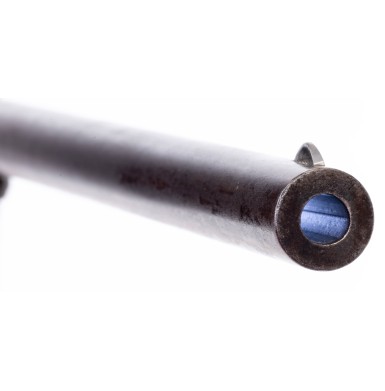Rare .35 Caliber Military Pattern 1st Model Maynard Carbine - Likely A Florida Purchase
- Product Code: FLA-4080
- Availability: Out Of Stock
-
$0.00
This is a VERY GOOD+ example of the scarce and desirable 1st Model Maynard Carbine. These guns were the invention of famous dental surgeon and firearms innovator Dr. Edward Maynard. Dr. Maynard is probably best known for his invention of the Maynard Tape Priming System, an automated priming system that utilized varnished strips of paper with small amounts of fulminate of mercury sandwiched between the two layers, similar to a modern-day child’s cap gun. The system advanced the roll of primers each time the hammer was cocked, and upon firing, sharp edge on the lower lip of the hammer’s face cut off the spent piece of priming tape. This system showed such promise and was so well thought of by the US Ordnance Department that the US Government paid Maynard $75,000 for the use of his priming system on the US Model 1855 series of arms. In addition to his tape-priming patent (#4,208, issued in 1845), Maynard received a total of 23 US patents related to innovations or improvements to firearms designs.
Maynard’s carbine design was an innovative breech-loading firearm, which used a proprietary brass cartridge loaded with powder and a lubricated bullet, relying upon Maynard’s tape priming system for ignition. Maynard paid the Springfield Armory $116.37 in 1853 to produce a full-scale model of his carbine, and this model was subsequently tested by the Ordnance Department in 1856 with very positive results. The successful trials resulted in the formation of the Massachusetts Arms Company in 1857, which was established for the purpose of producing Dr. Maynard’s breechloading long arm. The guns were produced with both carbine and rifle length barrels, which were 20” and 26” respectively, and were offered in both .35 (often misidentified as .36 or .37 caliber) and .50 caliber. The U.S. Army held additional trials of breechloading long arms in 1858, and the ease of operation of Maynard’s design, and its ability to function quickly and reliably, helped to win the Massachusetts Arms Company a contract for 400 of their .50 caliber military pattern carbines. These guns were ordered with fixed sights only, no long-range tang sight, and specified the use of a sling ring on the trigger plate tang, rather than on a traditional sling bar on the side of the carbine. These carbines were delivered in March and April of 1859. In late 1859 the US Revenue Cutter Service ordered an additional 200 Maynard carbines. While the first 100 arms ordered were referred to as “rifles”, it is believed that all 200 of these guns were in fact carbines, also chambered for the .50 Maynard cartridge. In February of 1860, the US Navy ordered 50 1st Model Maynard carbines, also in .50 caliber. While the Massachusetts Arms Company pursued what they perceived to be lucrative US government military contracts, they also produced sporting versions of the rifles and carbines, offering them for sale to the general public. The guns were available in both barrel lengths and calibers as well as in cased sets, often with a second, or even a third barrel, loading tools and a variety of optional accessories. Shotgun barrels were produced for use with the cased sporting sets as well.
According to arms researcher, author and historian James D McAulay, a number of famous (and soon to be famous) Southerners purchased Maynard sporting arms. These men included South Carolina’s Wade Hampton, Senator Robert Toombs of Georgia and Vice President John Breckenridge of Kentucky; all of whom would become Confederate Generals during the American Civil War.
The initial production goal of the Massachusetts Arms Company had been 5,000 arms. According to McAulay, as of October 1, 1860, the company had sold approximately 1,400 guns and had a total of 3,527 unsold arms in inventory. The inventory on hand was distributed as follows:
326 2nd Quality Arms (calibers and barrel lengths unspecified)
459 .50 caliber 20” Sporting Carbines
676 .50 caliber 20” Military Carbines
142 .50 caliber 26” Sporting Rifles
160 .50 caliber 26” Military Rifles
1,326 .35 caliber 20” Sporting Carbines
425 .35 caliber 20” Military Carbines
13 .35 caliber 26” Military Rifles
McAulay further notes that approximately 90% of this remaining inventory of 1st Model Maynard rifles and carbines were purchased by southern states and militia companies between October 1, 1860, and April of 1861. McAulay’s research indicates that the majority of the guns went to the states of Mississippi, Florida and Georgia. According to his figures, Florida acquired a total of 1,030 guns in December of 1860, all of which were carbine length (20”) and were chambered in .35 caliber. Mississippi acquired 800 guns in December of 1860 as well. Their purchase included both carbines (625 total) and rifles (26” barrel, a total of 175) and the guns were a mixture of .50 and .35, with all 175 of the rifles and 300 of the carbines being .50 and the remaining 325 carbines being .35. All 650 of the Georgia purchased guns were .50 caliber carbines. While Florida and Mississippi acquired their guns directly from the Massachusetts Arms Company, Georgia purchased their guns in January and March of 1861 from the firm of W.J. Syms & Brothers of New York City. Syms sold an additional 1,700 Maynards between October 1860 and May 1861. It is estimated that all but about 100 of these guns went to southern purchasers. McAulay notes that approximately 800 of these guns went to South Carolina and Louisiana. The balance of the estimated 800 “Confederate” sales by Syms were apparently made to Kentucky and Tennessee in April and May of 1861.
A substantial number of Confederate regiments were at least partially armed with 1st Model Maynard rifles and carbines during the Civil War, resulting in the guns (in both barrel lengths and calibers) being listed in the 1863 Confederate Ordnance Manual as a “standard issue” Confederate carbine. Some of the Confederate units armed with the guns included the 1st and 6th Florida Special Battalion of Infantry, 2nd Florida Cavalry, 5th & 9th Georgia Cavalry, Cobb’s Legion of Cavalry (Georgia), 1st Louisiana Cavalry, 11th Louisiana Infantry, 1st & 4th Mississippi Cavalry, 9th, 14th & 15th Mississippi Infantry, 18th North Carolina Infantry, 3rd Tennessee Cavalry, 35th Virginia Cavalry Battalion and the Waccamaw South Carolina Light Artillery. Some 1st Model Maynards were also issued for use on board the Confederate ironclad CSS Atlanta. The production of the 1st Model Maynard was brought to an end by a fire at the Massachusetts Arms Company factory in January of 1861. While the fire prevented production of arms for nearly two years, all of the completed arms on hand were saved. Dr. Maynard proceeded to buy out all of the various partners and owners of the company in 1862 and by 1863 the factory was back in business, producing the 2nd Model Maynard Carbine for the US Ordnance Department.
This 1st Model Maynard Carbine is in about VERY GOOD+ condition overall. The gun is a 20” barreled, .35 caliber, military configuration carbine. This makes it one of the 425 military pattern, .35 carbines on hand at the Massachusetts Arms Company on October 1, 1860. Based upon Confederate purchase records, this gun was almost certainly sold to either Florida or Mississippi. Florida acquired 1,030 of the .35 carbines and Mississippi acquired 325 of the .35 carbines. It appears that at least some of the Mississippi purchased carbines were of a “military” configuration, as they had a sling ring attached to an iron staple in the trigger guard tang along the toe of the stock. The gun is 100% complete and completely original. The carbine remains quite crisp, with mostly legible markings throughout. The gun is mechanically fine and fully functional, including the temperamental Maynard Tape Priming System. When these 1stModel Maynards are encountered today, the automated priming system usually does not function, as small internal parts are often broken or missing. This one is fully functional. The action of the carbine itself remains crisp and tight, with solid and secure lock up between the barrel and the frame. The carbine is marked in two lines on the lower right side of the frame:
MAYNARD ARMS CO.
WASHINGTON
It is additionally marked on the lower left side of the frame:
MANUFACTURED BY
MASS. ARMS CO.
CHICOPEE FALLS
and on the patchbox door:
MAYNARD PATENTEE
MAY 27 1851
JUNE 17 1856
These marks all remain legible and the two frame stamps are fairly clear but are difficult to read due to the oxidation and patination of the frame which does not provide the contrast necessary to easily read them. The patchbox door markings are partially worn away due to use. The inside of the patchbox has some remnants of the sometimes-encountered paper Maynard label. The carbine is serial number 1673 and is clearly marked with that number inside the tape primer door. The matching number 1673 is found on the bottom of the barrel, concealed by the frame. This is not always the case with these guns. Mixed numbers are not uncommon on 1st Model Maynard carbines, as existing guns regularly had their barrels and frames switched to corresponded to the configuration necessary to fill the order. For example, if an order called for .35 military carbines and not enough were available, .50 carbine barrels would be removed from military frames and .35 barrels installed on the frame to complete the order. Mixed numbers are commonly encountered on Confederate used examples for exactly this reason.
As the largest majority of the .35 caliber carbine length Maynards were purchased by Florida, it seems probable that this gun was one of those. One of the primary source documents that refers to the Florida acquisition of the guns comes from a January 1861 New York Herald article that noted that Florida had recently purchased “1,000 Maynard breechloading rifles”. In March of 1861 the governor of Florida offered to arm the majority of a newly raised regiment with the breechloading Maynard arms. In early 1862 Maynard arms were issued to the Marion Dragoons, the Marianna Dragoons, the Tallahassee Guards, the Beauregard Rangers and the Harris Troops. All of these early war cavalry companies were eventually incorporated into the 2nd Florida Cavalry. The 2nd Florida was organized during the late spring of 1862 and spent its Civil War service in the department of South Carolina, Georgia & Florida. The major engagements that they participated in were the battles of Olustee, Gainesville and Braddock’s Farm. The 1st and 6thFlorida Special Battalions of Infantry were also armed with Maynard breechloaders. The 1st Florida was organized in March of 1861, prior to the actual start of the war. They were engaged at Santa Rosa Island in October of 1861, and were subsequently transferred to the Confederate Army of Tennessee, where they served for the balance of the war. The 1st Florida was present at Shiloh, Perryville, Stones River, Chickamauga, the Atlanta Campaign, Nashville and the final campaign in North Carolina under Joe Johnston. The 6th Florida was raised in March of 1862 and spent its first months serving in East Tennessee. They eventually ended up the serving with the Army of Tennessee and fought all of the A.O.T. campaigns from Chickamauga through Atlanta, Nashville and North Carolina.
As previously noted, the gun is in crisp condition and has a lot of eye appeal. The frame has a faded smoky gray patina with scattered surface oxidation and some discoloration that hints at the original color casehardened finish. There is some light peppering and minor pinpricking on the frame and some light pitting around the breech area and near the percussion bolster, all from the caustic mercury in the primer pellets. The interior of the tape primer compartment shows some very light pitting as well, which is erosion from the primer residue. The original Maynard cone (nipple) is a relatively delicate part that is often found broken or damaged. The fact that the patchboxes of the guns were cut to carry a spare cone, suggest that this was a real issue during the period of use. This cone remains in very good and useable condition. The barrel retains some very minor traces of its original blued finish, most of which is confined to the nooks, crannies and protected areas of the barrel. There are also some flecks of blue evenly mingled with the lightly freckled, oxidized plum brown patina that covers the majority of the barrel. The barrel is mostly smooth but does show some very minor scattered light surface roughness and some light surface oxidation. There is lightly scattered peppering and pinpricking along the length of the barrel as well, as well as some scattered patches of light pitting, mostly around the breech area. The large rounded buttplate and patchbox both have a mixed brown patina over a pewter gray base color. The gun is in the “military” configuration and retains its original sling ring on the rear of the trigger plate tang. It also has the “military” sight package, which includes not only the flip up, long-range tang sight, but also a fixed “quick acquisition” rear sight on the breech of the barrel. The original adjustable tang sight is in place behind the hammer and the original front sight is present on the top of the barrel, near the muzzle. The bore of the carbine is in VERY GOOD+ to NEAR FINE condition. The .35 caliber bore is partly bright and retains very good, strong rifling. The bore shows only some light to moderate scattered frosting in the grooves, and some light pitting evenly distributed along the length of the bore. One of the unique features of the 1st Model Maynard carbine was the ability to adjust the “headspace” of the gun, by adjusting the relationship between the barrel breech and rear of the frame. This was accomplished by the means blocking wedges which could be moved slightly by turning two screws located at the bottom of the frame, forward of the trigger guard. The screws to adjust these blocks remain in place in the frame, and the relationship between the barrel and frame appears to be perfectly adjusted. The screws of the carbine remain crisp and sharp, with only a couple showing any real slot wear. The buttstock is in VERY GOOD+ to NEAR FINEcondition. The stock is solid and free of any breaks or repairs but does show a short grain crack on the reverse running about 2 ½” from the buttplate towards the wrist. This appears to be a surface grain crack that is not structural and appears stable. The buttstock shows the usual minor bumps and dings from handling and use but shows no abuse or damage. The butt is made from an attractively figured piece of walnut. The stock retains some of its original varnished finish, but as is typical of a cavalry carbine, much of the finish has been worn away from carry and use.
Overall, this is a very nice and extremely attractive example of a 1st Model Maynard Carbine. The gun is in fine mechanical condition, remains very tight and has a great bore. The gun really does qualify as being “unmolested and untouched”, as no one has ever messed with it or tried to clean the barrel or frame. The gun is in the desirable .35 military carbine configuration, which suggests that the gun is almost certainly a Confederate purchased arm went either to Florida or possibly Mississippi. 1st Model Maynard carbines do not appear on the market very often, and when they do, they often show significant wear and numerous replacement parts. This is a very crisp example of what was certainly a Confederate used 1st Model Maynard that I am sure you will be very happy with, that will be a fine addition to any display of secondary Confederate cavalry carbines, or a display that centers on Florida or Mississippi related arms.
ON HOLD/LAYAWAY
Tags: Rare, .35, Caliber, Military, Pattern, 1st, Model, Maynard, Carbine, Likely, A, Florida, Purchase

